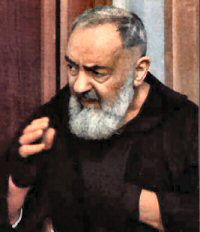Ordinary Time: September 23rd
Memorial of St. Padre Pio
Other Commemorations: St. Linus, Pope and Martyr (RM); Sts. Zechariah and Elizabeth (RM) ; Other Titles: Padre Pio of Pietrelcina; Francesco Forgione
Free eBook:

|
| Free eBook: Liturgical Year 2023-2024, Vol. 4 |
» Enjoy our Liturgical Seasons series of e-books!
Padre Pio was born in 1887 in the small Italian village of Pietrelcina. He joined the Capuchin Friars at the age of sixteen and was ordained a priest seven years later. For fifty years at the monastery of San Giovanni Rotundo he was a much sought after spiritual advisor, confessor, and intercessor whose life was devoted to the Eucharist and prayer. Yet despite such notoriety, he would often say, "I only want to be a poor friar who prays."
According to the 1962 Missal of Bl. John XXIII the Extraordinary Form of the Roman Rite, today is the feast of St. Linus, the immediate successor of St. Peter in the government of the Church. He is mentioned after the apostles in the Roman Canon of the Mass (Eucharistic Prayer I). It is also the feast of St. Thecla, a virgin of Asia Minor in the early days of the Church. Her cultus, which is very ancient, goes back to the second century. She is considered the first woman martyr.
St. Pio or Pius of Pietrelcina
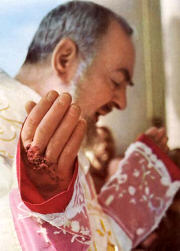 Born to a southern Italian farm family, the son of Grazio, a shepherd. At age 15 he entered the novitiate of the Capuchin Friars in Morcone, and joined the order at age 19. He suffered several health problems, and at one point his family thought he had tuberculosis. He was ordained at age 22 on 10 August 1910.
Born to a southern Italian farm family, the son of Grazio, a shepherd. At age 15 he entered the novitiate of the Capuchin Friars in Morcone, and joined the order at age 19. He suffered several health problems, and at one point his family thought he had tuberculosis. He was ordained at age 22 on 10 August 1910.
While praying before a cross on September 20, 1918, Padre Pio received the stigmata. He is the first priest ever to be so blessed. As word spread, especially after American soldiers brought home stories of Padre Pio following WWII, the priest himself became a point of pilgrimage for both the pious and the curious. He would hear confessions by the hour, reportedly able to read the consciences of those who held back. He was reportedly able to bi-locate, levitate, and heal by touch.
In 1956 he founded the House for the Relief of Suffering, a hospital that serves 60,000 a year. Padre Pio died on September 23, 1968 at age 81.
Today there are over 400,000 members worldwide in prayer groups begun by Padre Pio in the 1920s.
His canonization miracle involved the cure of Matteo Pio Colella, age 7, the son of a doctor who works in the House for Relief of Suffering, the hospital in San Giovanni Rotondo. On the night of June 20, 2000, Matteo was admitted to the intensive care unit of the hospital with meningitis. By morning doctors had lost hope for him as nine of the boy's internal organs had ceased to give signs of life. That night, during a prayer vigil attended by Matteo's mother and some Capuchin friars of Padre Pio's monastery, the child's condition improved suddenly. When he awoke from the coma, Matteo said that he had seen an elderly man with a white beard and a long, brown habit, who said to him: "Don't worry, you will soon be cured." The miracle was approved by the Congregation and Pope John Paul II on 20 December 2001.
—Adapted from the Discount Catholic Store, Inc.
Highlights and Things to Do:
- St. Pio is a saint of the last century, so there are many pictures and biographies to read more about his life. Having this gift of the stigmata was very hard on his life — both physically and emotionally. Find out more about the stigmata and his other mystical gifts, such as bilocation. St. Pio also had great devotion to his guardian angel.
- From the Catholic Culture library: Biography of Padre Pio of Pietrelcina, The Devil and Padre Pio, Five Maxims for Living a Devout Life and His Wounds Spoke of God's Love for All. There are many other documents in the library which may be found by searching for "pio".
- Read more about St. Padre Pio:
- The remains of St. Pio rest in the crypt below Santuario di San Pio da Pietrelcina in San Giovanni Rotondo, Italy.
- Visit the Padre Pio Shrine in New York City.
- See Catholic Cuisine for some original feast day food ideas.
St. Linus
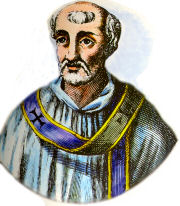 Following the crucifixion of Peter, Linus, who had served as an assistant to the apostle, continued the leadership of the Church, for once the Christian faith had been firmly established in Rome, Peter and Paul had commended Linus to this responsibility. However, because the one-man episcopate had not yet emerged in Rome, we have no way of knowing exactly what duties were expected of Linus. In a letter directed to the Oriental churches, Linus told how Peter's body was taken from the cross by Marcellus, bathed in milk and wine, and embalmed with precious spices.
Following the crucifixion of Peter, Linus, who had served as an assistant to the apostle, continued the leadership of the Church, for once the Christian faith had been firmly established in Rome, Peter and Paul had commended Linus to this responsibility. However, because the one-man episcopate had not yet emerged in Rome, we have no way of knowing exactly what duties were expected of Linus. In a letter directed to the Oriental churches, Linus told how Peter's body was taken from the cross by Marcellus, bathed in milk and wine, and embalmed with precious spices.
Linus, believed to be the son of Herculanus, was an Italian from the region of Tuscany. He has been identified by the early writer, Eusebius, as the same Linus who is mentioned by St. Paul in his letter of salutation from Rome to Timothy in Ephesus. His episcopate is said to have been approximately twelve years. A brief respite from persecution for the brethren is said to have existed at this time, for legend has it that Nero, in a frightening vision, was so chastised by Peter that he abandoned the wrath which he had once so fiercely set upon the Christians.
Much is unknown of Linus, to be sure, but it is said that he, at Peter's direction, decreed that all women would now cover their heads when entering a church. In the ancient canon of the Mass, his name is cited after those of Peter and Paul.
According to legend, Linus was martyred and buried on the Vatican Hill alongside his beloved Peter.
—Excerpted from The Popes: A Papal History, J.V. Bartlett
Symbols and Representation: Triple cross; fleeing demons.
Highlights and Things To Do:
- Read more about St. Linus:
- It is thought that Linus is buried in the Vatican. See List of Popes buried in St. Peter's and Wikipedia for further information.
St. Elizabeth
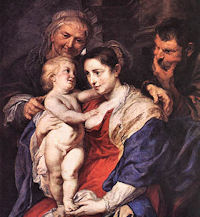 The name Elizabeth, which has been borne by several saints, means in Hebrew "worshiper of God." All that we know of Elizabeth, wife of Zachary and mother of John the Baptist, is to be found in the book of Luke. A descendant of the priestly line of Aaron, she was a kinswoman - how close we are not told – of the Virgin Mary.
The name Elizabeth, which has been borne by several saints, means in Hebrew "worshiper of God." All that we know of Elizabeth, wife of Zachary and mother of John the Baptist, is to be found in the book of Luke. A descendant of the priestly line of Aaron, she was a kinswoman - how close we are not told – of the Virgin Mary.
According to the Gospel, Elizabeth had lived a blameless life with her husband in one of the hill-towns of Judea. Having reached an advanced age with her prayers for a son unanswered, she thought that her barrenness was a reproach. One day, while Zachary was serving in the temple, the Angel Gabriel appeared at the right of the altar, and announced that a son would be born to Elizabeth. It was in the sixth month of her pregnancy that the Virgin Mary came to visit her - a touching and beautiful scene pictured by many great artists.
The Angel Gabriel, having lately announced to Mary the destiny that awaited her, also told her that her kinswoman Elizabeth was with child. The Virgin Mary, eager to share in Elizabeth's happiness and to confide that she too would bear a child, traveled down the dusty road from Nazareth. On Mary's arrival, she was amazed when Elizabeth, having foreseen knowledge, greeted her as "mother of my Lord." Elizabeth's salutation was in these words: "Blessed art thou among women and blessed is the fruit of thy womb. And how have I deserved that the mother of my Lord should come to me? For behold, the moment that the sound of thy greeting came to my ears, the babe in my womb leapt for joy. And blessed is she who has believed, because the things promised her by the Lord shall be accomplished."
The Gospel story tells us further that at Elizabeth's delivery her friends and neighbors rejoiced with her, and when the child was brought to be circumcised, they were going to call him after his father Zachary, but his mother said, "His name shall be John."
—Excerpted from Lives of Saints, Published by John J. Crawley & Co., Inc.
Patronage: expectant mothers, diocese of Fulda, Germany.
Often Depicted As: elderly woman holding the infant John the Baptist; pregnant woman with the Virgin Mary; in the company of Saint Zachary
St. Zachary
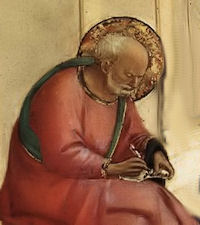 St. Zachary, whose feast is celebrated on the same day as that of St. Elizabeth, his wife, was of the tribe of Abia, and a member of the priestly class. It was customary for the priests whose week it was to serve in the temple to cast lots each day for the performance of the various rituals. One day, during Zachary's period of service, the privilege of offering incense on the altar in the holy place fell to him, and while he was alone before the altar performing this rite, the Angel Gabriel appeared to him, standing at the right of the altar. Zachary was troubled and afraid. Then Gabriel spoke, saying that the prayers of the priest and his wife would be answered; a son was to be born to them, and his name was to be John. Zachary found this hard to believe, for both he and Elizabeth were advanced in years. Overcoming his fear, he asked the angel for some sign. Because he doubted, the angel announced that Zachary would be stricken dumb and would regain the power of speech only when the prophecy was fulfilled. Then the angel disappeared and Zachary came forth from the temple. The people saw that he was unable to speak and they knew then that he had received a vision from the Lord.
St. Zachary, whose feast is celebrated on the same day as that of St. Elizabeth, his wife, was of the tribe of Abia, and a member of the priestly class. It was customary for the priests whose week it was to serve in the temple to cast lots each day for the performance of the various rituals. One day, during Zachary's period of service, the privilege of offering incense on the altar in the holy place fell to him, and while he was alone before the altar performing this rite, the Angel Gabriel appeared to him, standing at the right of the altar. Zachary was troubled and afraid. Then Gabriel spoke, saying that the prayers of the priest and his wife would be answered; a son was to be born to them, and his name was to be John. Zachary found this hard to believe, for both he and Elizabeth were advanced in years. Overcoming his fear, he asked the angel for some sign. Because he doubted, the angel announced that Zachary would be stricken dumb and would regain the power of speech only when the prophecy was fulfilled. Then the angel disappeared and Zachary came forth from the temple. The people saw that he was unable to speak and they knew then that he had received a vision from the Lord.
Elizabeth conceived and gave birth to the one who was to be the Precursor of the Lord. After eight days, when the child was about to be circumcised, Elizabeth told the people that he was to be named John; and Zachary, still unable to speak, asked for a tablet, and on it he wrote the words, "John is his name." At this moment Zachary's tongue was loosed, and he began to praise the Lord. The New Testament tells us nothing further concerning St. Zachary. In Hebrew his name means "Jehovah hath remembered."
—Excerpted from Lives of Saints, Published by John J. Crawley & Co., Inc.
Highlights and Things To Do:
- How beautiful that from the lips of Elizabeth and Zechariah we have parts of prayers that are prayed universally throughout the ages: Elizabeth's praise: "Blessed are you among women and blessed is the fruit of your womb!" became part of the Hail Mary and Zechariah's praise after his tongue was looked became the Canticle Benedictus, prayed every day for Morning Prayer in the Divine Office.
- Read more about Zechariah and Elizabeth:
- See the National Gallery of Art for a close-up on The Visitation with Saints Nicholas and Anthony Abbot by Piero di Cosimo.
Meditation: Ember Saturday, A day for expiation and thanksgiving!
This excerpt from Pius Parsch is based on the 1962 Missal. The current Missal does not include special propers and readings for Ember Days.
1. Holy Mass (Venite). Ember Saturday is the official thanksgiving day for all the blessings of the past quarter-year. Especially in autumn when we garner the fruits of nature should we be more conscious of God’s Providence both in the temporal and spiritual orders. In ancient times today’s Mass served as a thanksgiving sacrifice and as a renewals of the Christian covenant with God. The text presumes that the Ember days are the Christian counterpart to the Old Testament feasts of Atonement and Tabernacles, highlighting penance and and gratitude respectively.
The liturgical celebration, observed during the night between Saturday and Sunday and of obligation for all the faithful, was unusually festive. The faithful gathered at St. Peter’s for an entrance song the Invitatory (Psalm 94) was sung. The first four Lessons belonged specifically to the night-vigil and formed a greeting worthy of the enthroned King. The Readings tap the marrow of the Ember celebration, its connection with the Jewish feasts of the seventh month, Yom Kippur and the feast of Tabernacles. The autumn Ember days are days of penance for past failings and of gratitude for the harvest (and redemption); such too is the spiritual import of the Lessons. The first reviews the Mosaic legislation concerning the Day of Atonement, the second concerning the feast of Tabernacles, Israel’s great thanksgiving feast.
The two Graduals echo their respective Lessons; the first “Forgive” (Day of Atonement), the second, “How lovely are Thy tabernacles” (feast of Tabernacles). The third and fourth Lessons, from the prophets Micheas and Zacharias, are comforting messages in which God reaffirms His readiness to forgive the sins of His people and to grant them good things provided they remain faithful. God is also concerned over the manner in which we fast: “The fast of the fourth month, and the fast of the fifth, and the fast of the seventh, and the fast of the tenth shall be to the house of Judah joy and gladness and a great solemnity!” By which our Ember days, of course, are meant. The Orations offer God our festive fast and plead forgiveness. As on other Ember Saturdays, the fifth Lesson is already part of the morning service; the assembled faithful are praying Lauds; the three youths in the fiery furnace prefigure the resurrection of Christ and of Christians.
In the Epistle St. Paul shows how the ceremonies of the old covenant were types of the new; our day of atonement is Good Friday when Christ, the divine High Priest, entered the most holy sanctuary of heaven with His own Blood and wrought eternal redemption; every Mass is Good Friday repeated. In the Tract we chant the shortest Laud psalm as we express our gratefulness for God’s merciful work of redemption and HIs fidelity in fulfilling the prophecies.
Presently the High Priest Himself appears, first “teaching on the Sabbath” (in the Foremass), then offering Himself (in the Oblation). The unfruitful “fig tree in the orchard” and the “bowed-down woman” are the faithful. God is the landlord, Christ the pleading gardener; till now we have been unfruitful.
We also resemble the bowed-down woman; wholly taken up with earthy concerns, too often we are “unable to look upward”; but on this Christian Sabbath, Christ seeks “to free us from the bonds of Satan” and make us spiritually “erect.” Thus the Gospel insinuates the workings of grace in today’s holy Sacrifice.
At the sacrificial Banquet we once more recall the institution of the feast of Tabernacles as a remembrance of the deliverance from Egypt and the wanderings through the wilderness—for the Eucharist is the fulfillment of those two historical events by providing deliverance from sin and the true Manna from heaven. A classic, thought-packed Postcommunion: May the sacramental energy of the Eucharist realize its power in us, and may we one day enjoy face to face what now we see in a veiled manner. Three realities are noted: the first is the sign—this shows the sacrament. Underneath the sign is hidden the second reality, the sacrament’s efficacy—what the sacraments contain. And lastly, the rerun veritas, the future unveiling.
2. A “Spiritual Renewal” Day. For a “day of recollection” no better meditation points could be found than those in the Lessons of today’s Ember Mass. Of the two areas of thought proper to the formulary, viz., the Ember festivity is the Christian “Day of Atonement” and the Christian Feast of Tabernacles (or thanksgiving day at harvest time), let us pursue the former in some detail.
a) The Old Testament type. The Day of Atonement, Yom Kippur, was the great penitential observance of Mosaic Law, Israel’s “confession day.” With us “penance days” are not feast days, but among the Jews it was otherwise; Yom Kippur was a day of strict rest, absolutely no type of work was permitted and the spirit of the occasion was festive, celebrabitis. The day’s liturgy exemplified the nation’s effort to expiate sin; on this one day of the year, the high priest would enter the Holy of Holies with sacrificial blood and sprinkle the ark of the covenant in atonement for his own and his people’s sins. Meanwhile the people did penance through fasting, humbling themselves before Yahweh.
b) The New Testament fulfillment. Mosaic festivals were shadows which took on flesh and blood in the Church of Christ. Good Friday was the real, the unique day of atonement in the sight of God. How well St. Paul affirmed this truth in the Epistle of today’s Mass: “Christ appeared as the high priest of coming (Messianic) blessings. He entered the greater and more perfect tabernacle not made by human hands (i.e., heavenly in nature) not with the blood of goats and steers but with His own blood—once and for all He entered the (heavenly) Holy of Holies—after He had effected an eternal redemption (i.e., one with lasting effects in contrast to the annually repeated Jewish day of atonement).” For the sacrifice on the Cross constituted the perfect reconciliation of God with mankind; and every holy Mass, as it renders present that sacrifice on Golgotha, is Yom Kippur par excellence.
Every Sunday then would be the Christian atonement feast. But because we Christians are so irresponsive and dull to the inner nature of spiritual realities, holy Church introduced special expiation days during the course of the Church year. Among these are Ember days. Ember Saturdays, particularly September Ember Saturday, have preserved best this original spirit. Anyone who seeks to develop his spiritual life on a liturgical basis would have to use the Ember days during the four seasons as times of genuine spiritual renewal. The peculiar means of keeping these days is evident from the liturgy itself—acts of penance and fasting, confession of sin, humbling ourselves before God and neighbor, and nevertheless rejoicing, in the best sense of the word. Our conduct would exemplify the prophet’s statement (fourth Lesson), “The fast proper to the fourth, fifth, seventh and tenth months (i.e., the four Ember weeks) should mean joy and exultation to the house of Judah (viz,, Catholics) and high festival; you only need to love truth (obedience) and peace.”
c) Application. God appeals directly to my heart in the Gospel. The two parables, one in word and one in sign, should move me deeply. I am that barren fig tree. The infinitely just God is the landlord, our Savior the pleading caretaker. If God should summon me to His judgement seat today (the command to destroy the tree), would there be any “fruit”? To what extent would I resemble the barren fig tree? Why does it occupy ground? But Christ intercedes, says a kindly word in my behalf: “Perhaps there will be some return—next crop! If not, it can then be cut down.” The coming quarter-year mark must mark a change, genuine improvement.
The parable in sign is equally instructive. My soul is so badly bowed down to earth, it find “looking upwards” toward heavenly realities extremely painful. Christ must make me stand erect again. The coming season as no other is the season of hope, of preparation for the parousia, of longing for the heavenly Jerusalem, of expectation for the returning Lord. Jesus, have mercy. Free me from stooping down to the earthly, the sensual. Straighten me out for heaven. Now! Jesus, have mercy.
—Excerpted from Pius Parsch, Year of Grace, Volume 5.
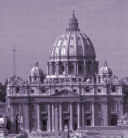 Ember Saturday of the Autumn or September Embertide
Ember Saturday of the Autumn or September Embertide
Station with San Pietro in Vaticano (St. Peter's in the Vatican):
We celebrate this closing and thanksgiving day of Ember Week "in the house of Peter." It is the night between Saturday and Sunday as in the spirit of the ancient Church we gather at St. Peter's, the station for all Christendom. "Let us fast on Wednesday and Friday, and on Saturday let us celebrate the vigil at the tomb of blessed Peter the Apostle, by whose merits and prayers we believe that we shall be aided, so that we may please our merciful God by our fast and prayer." That was the announcement made by the Great Leo to the holy people of God fifteen centuries ago. That is the program for Christ’s flock of today. "Let us celebrate the vigil at the tomb of blessed Peter"! This ember vigil, like all other vigils, was held at night and ended at daybreak with the celebration of the Holy Eucharist, the mystery of "Light and Life" (phos-zoe). "Watching, prayer, fast, sorrow for past transgressions, resolutions for the future, conferring of holy orders, offering of grapes (wine), and the climax, the eucharistic Banquet, were the eight milestones on this nocturnal journey. (Msgr. Martin Hellriegel)
For more on San Pietro in Vaticano, see:
For further information on the Station Churches, see The Stational Church.




